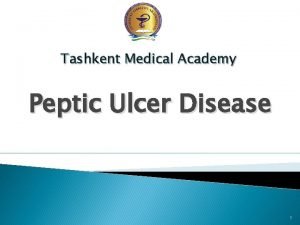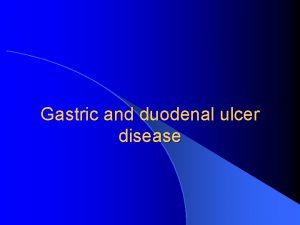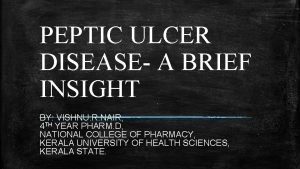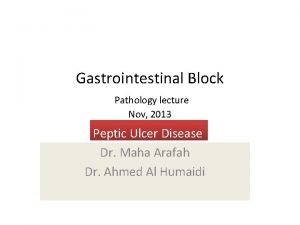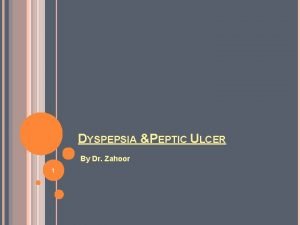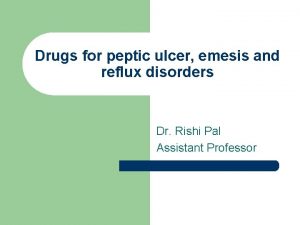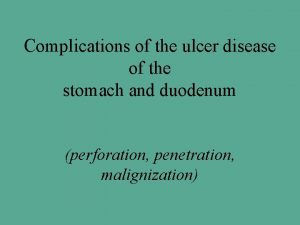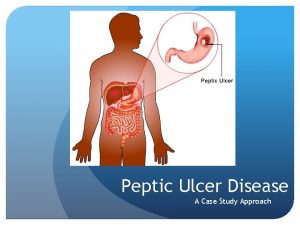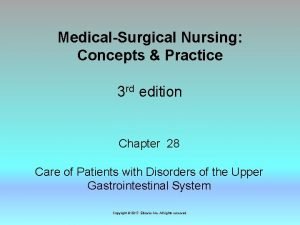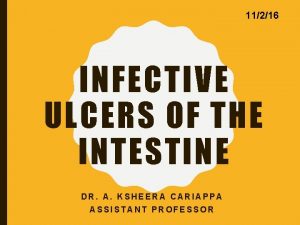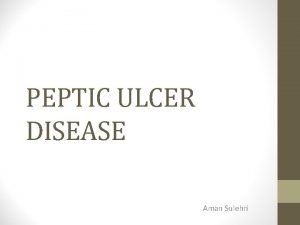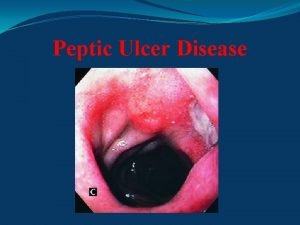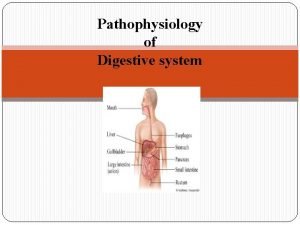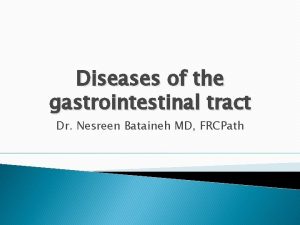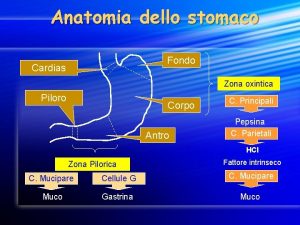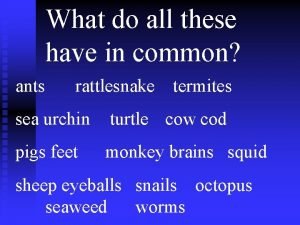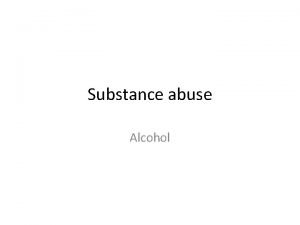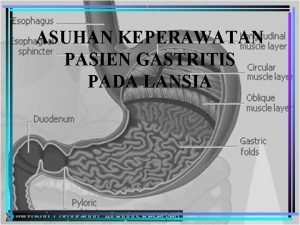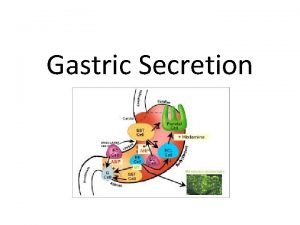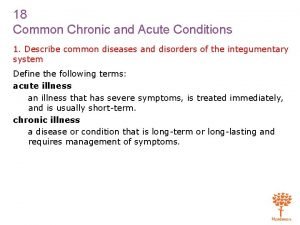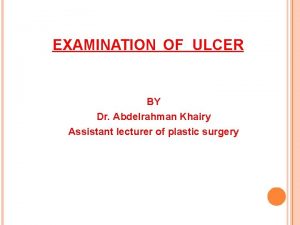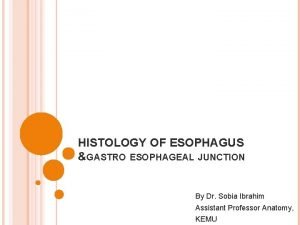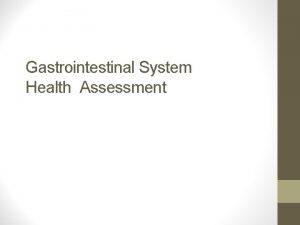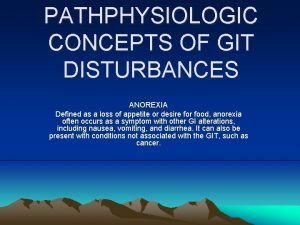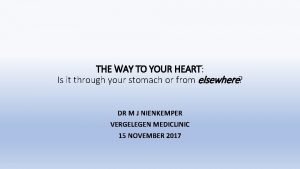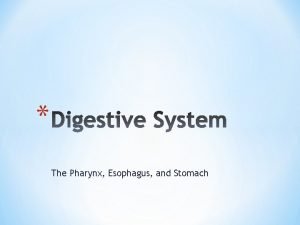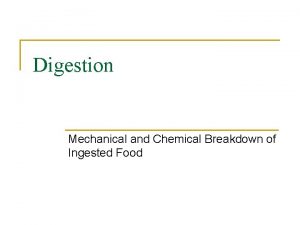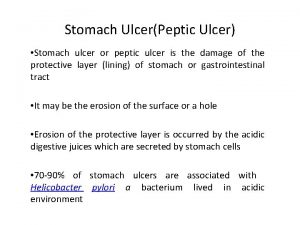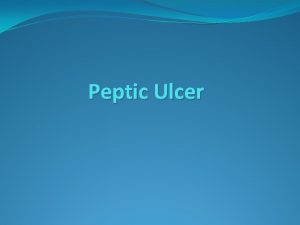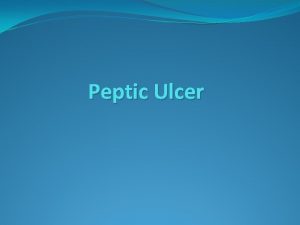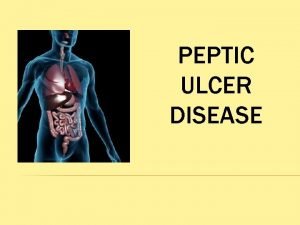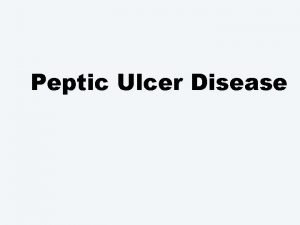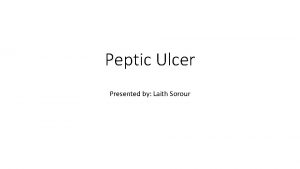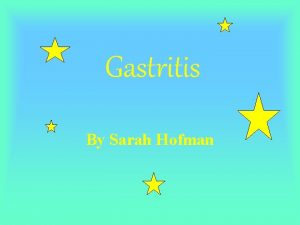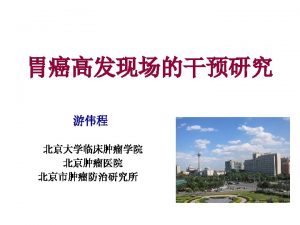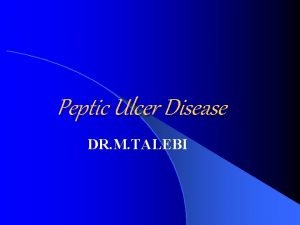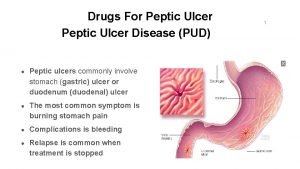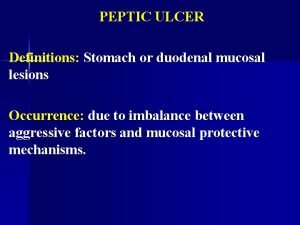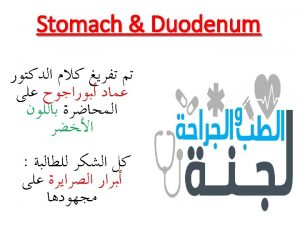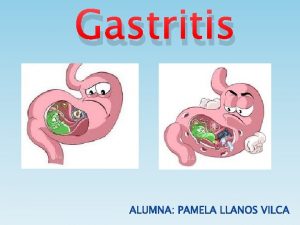Chronic gastritis Peptic ulcer of a stomach and



































![malignant [neoplastic] transformation malignant [neoplastic] transformation](https://slidetodoc.com/presentation_image/5201794c20fac6aeb210068557d0d031/image-36.jpg)














- Slides: 50

Chronic gastritis. Peptic ulcer of a stomach and duodenum. Ethiology. Clinical pattern. Daignostics. Complications. Principles of treatment. Khabarova N. A.



• Gastritis is an inflammation of the lining of the stomach. • There are many possible causes of this disorder including an infection, an irritant, an autoimmune disorder, or a backup of bile into the stomach. • Gastritis can occur suddenly (acute gastritis) or gradually (chronic gastritis).

CLASSIFICATION OF CHRONIC GASTRITIS • • • ADOPTED AT THE 9 TH INTERNATIONAL CONGRESS OF GASTROENTEROLOGISTS ( SYDNEY 1990) , MODIFICATED IN HOUSTON IN 1994 1. CHRONIC NONATROPHIC ( CHRONIC HELICOBACTERIC GASTRITIS , CHRONIC ANTRIAL , TYPE «B» ) , WHICH REPRESENTS ALMOST 70 % OF ALL GASTRITS TYPES. 2. CHRONIC ATROPHIC GASTRITIS ( AUTOIMMUNE , DIFFUSE GASTRITIS OF STOMACH CORPUS , ASSOCIATED WITH PERNICIOUS ANEMIA , ATROPHIC , TYPE A ) , PRESENT IN 15 – 18 % CASES OF CHRONIC GASTRITIES ; CHRONIC MULTIFOCAL GASTRITIS. 3. SPECIAL FORMS OF CHRONIC GASTRITIS : CHEMICAL ( REACTIVE CHRONIC GASTRITIS , WHICH OCCURS IN CASE OF BILE REFLUX ( ABOUT 15 % ) , AFTER NSAID THERAPY ( ABOUT 10 % ) ; GRANULOMATOUS ( IN CASE OF CROHN’S DISEASE , SARKOIDOSIS , TUBERCULOSIS ) ; EOZINOPHILIC ( IN CASE OF BRONCHIAL ASTHMA , FOOD ALLERGY ) ; LYMPHOCYTIC ( WITH MANIFESTED LYMPHOCYTIC INFILTRATION OF EPITHELIUM ) ; GIGANT HYPERTROPHIC GASTRITIS ( MENETRIER’S DISEASE ) ; RADIATION GASTRITIS

• Type B (Chronic antral gastritis) • It principally affects the antrum and is associated with the presence of Helicobacter pylori on the surface epithelium. If organism is not present serological tests show antibodies against Helicobacter pylori.

• Type A (autoimmune gastritis) • It is an autoimmune disorder involving the fundic glands of stomach that secretes both the intrinsic factor and acid. The antibodies destroy the parietal cells with loss of acid and intrinsic factor.

• • • Signs and Symptoms The most common symptoms of gastritis are stomach upset and pain. The following are other symptoms of gastritis. Indigestion (also called dyspepsia) Heartburn Abdominal pain Hiccups Loss of appetite Nausea Vomiting, possibly of blood (called hematemesis) or material that looks like coffee-grounds Dark stools

Diagnosis There are several tests that may be done to make a diagnosis. These include endoscopy of the stomach.



normal mucous coat of stomach acute gastritis

Type B (Chronic antral gastritis) Type A (autoimmune gastritis)

Chronic gastritis Type B

Type A (autoimmune gastritis)

The laboratory tests may need will depend on the specific cause of gastritis. A stool test may be used to check for the presence of blood A biopsy may be taken of the tissues of esophagus or stomach to determine the cause of discomfort. A breath test may detect H. pylori, or samples from esophagus or stomach may be taken to look for this organism.

A breath test

H. Pylori

H. Pylori


• Treatment • The treatment of gastritis depends on the cause of the problem. Some causes may resolve by themselves over time, or may be relieved by stopping the ingestion of irritating substances such as alcohol, tobacco, and aspirin. Medications are often necessary to relieve symptoms, eradicate an infection such as H. pylori, and prevent or treat complications from gastritis such as an ulcer.

• Medications • Helicobactor pylori infestation, a common bacterial cause of gastritis and ulcers, is typically treated with a combination of drugs. The typical combination includes antibiotics, a bismuth compound, and a proton pump inhibitor. • In addition to the medications used for Helicobacter pylori infection, other medications that may be used to relieve symptoms of gastritis include those that reduce stomach acid secretion: • Antacids such as calcium carbonate and magnesium hydroxide with aluminum salts • H 2 blockers such as ranitidine, cimetidine, nizatidine, and famotidine • Proton pump inhibitors such as omeprazole and lansoprazole • Drugs that reduce stomach acid secretion help protect against or treat ulcers. Other drugs used for ulcers include: • Misoprostol – protects against the major intestinal toxicity of NSAIDS, and can reduce the formation of ulcers • Sucralfate – helps to heal ulcers in the stomach • In case of atrophic gastritis, either stimulating or replacement therapy is administered. Stimulating therapy includes metabolic drugs, replacement therapy includes gastric juice or acidin pepsin.

Peptic Ulcer Peptic ulcer is a general chronic and relapsing disease characterized by seasonal exacerbations with ulceration of the stomach wall or the duodenum.

• Causes • When the stomach's natural protections from the damaging effects of • • digestive juices stop working or the acid production is too overwhelming for these protective defenses to work properly, you can get an ulcer. There a few different ways this happens. Helicobacter pylori (H. pylori), a bacterial organism, is responsible for most ulcers. This organism weakens the protective coating of the stomach and duodenum and allows the damaging digestive juices to irritate the sensitive lining below. Non-steroidal anti-inflammatory drugs (NSAIDs) – ongoing use of this class of medications is the second most common cause of ulcers. Zollinger–Ellison syndrome. Other causes of ulcers are conditions that can result in direct damage to the wall of the stomach or duodenum such as heavy use of alcohol, radiation therapy, burns, and physical injury

PATHOGENESIS


• Signs and Symptoms • Abdominal pain with a • • burning or gnawing sensation Heartburn Indigestion (dyspepsia) Belching Nausea Vomiting Poor appetite Weight loss

PAIN Site: Epigastrium Character: Burning in character Radiation: Pain is localized and patient is able to point it with his one finger "pointing sign". Time of pain: Soon after eating within 15 -30 minutes in gastric ulcer while 2 -3 hours after eating in duodenal ulcer that frequently awakens the patient at night. Relation with food: Patient with gastric ulcer are afraid to eat because it causes pain due to release of acid in response to food. Patients with duodenal ulcer feel pain in empty stomach and get relief after taking food which causes partial neutralization of acid.

• • • • Aggravating factors: Smoking Excessive intake of coffee and tea Alcohol Eating precipitates pain in gastric ulcer while missing a meal in duodenal ulcer. Relieving factors: • Antacids and milk • . Vomiting relieves pain in gastric ulcer • Intake of food relieves pain in duodenal ulcer Periodicity: Pain comes and goes in a 2 -3 month cycle in gastric ulcer In duodenal ulcer episode occurs with 4 -6 month cycle, often worse in spring and autumn. Duration of attack: A few weeks in gastric ulcer A month or two in duodenal ulcer

• VOMITING • Vomiting relieves pain of gastric ulcer and some patients force themselves to vomit after eating to relieve symptoms. It is uncommon in duodenal ulcer. ON CLINICAL EXAMINATION • Deep tenderness in epigastrium is present in most of the cases. Anemia may be present.

• COMPLICATIONS: Hemorrhage melena

Penetration


Perforation

Malignization
![malignant neoplastic transformation malignant [neoplastic] transformation](https://slidetodoc.com/presentation_image/5201794c20fac6aeb210068557d0d031/image-36.jpg)
malignant [neoplastic] transformation

Pyloric obstruction

Investigation • One of two tests will be performed to try to identify an ulcer: • Upper gastrointestinal (GI) series • Endoscopy DIAGNOSIS OF H. PYLORI • Histology • Rapid urease activity test • Other tests that may be performed to look for H. pylori include a blood test checking for antibodies to this organism, a breath test after drinking a substance called urea, and a stool test looking for the organism in the feces.



Lumen of the duodenum of a healthy human male. White spots are reflections of the light source.

Endoscopy


Endoscopy




• Treatment • The main goals for treating a peptic ulcer include eliminating the underlying cause (particularly H. pylori infection or use of NSAIDs), preventing further damage and complications, and reducing the risk of recurrence. Medication is almost always needed to alleviate symptoms and must be used to eradicate H. pylori. Surgery is required for certain serious or life-threatening complications of peptic ulcers and may be considered if medications are not working. Even with medications, many lifestyle factors, including making changes in diet, are important.

• Medications • If you have H. pylori, you will probably be prescribed three different medications. "Triple therapy" (including a proton pump inhibitor [for example, omeprazole] to reduce acid production and two antibiotics to get rid of the organism) is commonly used to treat H. pylorirelated ulcers. Instead of one of the antibiotics, bismuth salicylate may be third medication recommended. This drug, available over the counter, coats and soothes the stomach, protecting it from the damaging effects of acid. Two, rather than three, drug regimens are currently being developed.

• Some of the same drugs are used for non-H. pylori • • • ulcers as well as for symptoms (like indigestion) due to ulcers of any cause: Antacids, available over the counter, may relieve heartburn or indigestion but will not treat an ulcer H 2 blockers, such as cimetidine, ranitidine, nizatidine, and famotidine, reduce gastric acid secretion. Misoprostol Proton-pump inhibitors, including esomeprazole, lansoprazole, omeprazole, pantoprazole, and rabeprazole, decrease gastric acid production. Sucralfate
 Gastritis
Gastritis Gastric ulcer vs duodenal ulcer
Gastric ulcer vs duodenal ulcer Gastric ulcer barium swallow
Gastric ulcer barium swallow Triple therapy for peptic ulcer disease
Triple therapy for peptic ulcer disease Antrectomy
Antrectomy Triple therapy for peptic ulcer disease
Triple therapy for peptic ulcer disease Peptic ulcer causes
Peptic ulcer causes Patient counselling for peptic ulcer disease
Patient counselling for peptic ulcer disease Gastric ulcer
Gastric ulcer Peptic ulcer disease
Peptic ulcer disease Emetics
Emetics Turburculousis
Turburculousis Peptic ulcer case study
Peptic ulcer case study Peptic ulcer diseas
Peptic ulcer diseas Acholorhydria
Acholorhydria Arsas symptoms
Arsas symptoms Ulcar notch
Ulcar notch Typhoid and tuberculous ulcer
Typhoid and tuberculous ulcer Niche and notch in gastric ulcer
Niche and notch in gastric ulcer Gastric ulcer vs duodenal ulcer
Gastric ulcer vs duodenal ulcer Gastritis type a and b
Gastritis type a and b Osteomalacia prefix and suffix
Osteomalacia prefix and suffix Gastritis types
Gastritis types Lp gerontik gastritis
Lp gerontik gastritis Ulcerq
Ulcerq Mucosa oxintica
Mucosa oxintica Askep gerontik dengan gastritis
Askep gerontik dengan gastritis Mucosa gastritis
Mucosa gastritis Acute gastritis
Acute gastritis Alkaline mucus
Alkaline mucus Gastritis nursing diagnosis slideshare
Gastritis nursing diagnosis slideshare Gastrtis
Gastrtis Askep gastritis
Askep gastritis Askep gastritis pada lansia
Askep gastritis pada lansia Gastric secretion composition
Gastric secretion composition Cardinal sign of inflammation
Cardinal sign of inflammation 18 common chronic and acute conditions
18 common chronic and acute conditions Morphology of acute inflammation
Morphology of acute inflammation Lll leukemia
Lll leukemia Phoenix abscess
Phoenix abscess Beaded edge ulcer
Beaded edge ulcer Slopping edge ulcer
Slopping edge ulcer Ge junction histology
Ge junction histology Abd quadrants
Abd quadrants Degluttination
Degluttination Excessive acid production
Excessive acid production Stomach and heart
Stomach and heart About stomach
About stomach Carbohydrate digestion
Carbohydrate digestion Chronic blood loss
Chronic blood loss Definition of chronic toxicity
Definition of chronic toxicity


